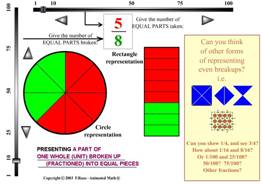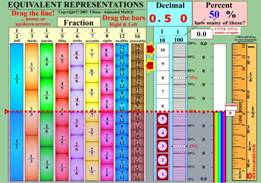


DATE: Jan 3, 2009
COURSE TITLE: Fractions 3rd Grade
LESSON: Beginning Fractions



TOPIC: CA Mathematics Content Standards – Third Grade - Fractions
3.0 Students understand the relationship between whole numbers, simple fractions, and decimals:
3.1 Compare fractions represented by drawings or concrete materials to show equivalence and to add and subtract simple fractions in context (e.g., 1/2 of a pizza is the same amount as 2/4 of another pizza that is the same size; show that 3/8 is larger than 1/4).
3.2 Add and subtract simple fractions (e.g., determine that 1/8 + 3/8 is the same as 1/2).
3.3 Solve problems involving addition, subtraction, multiplication, and division of money amounts in decimal notation and multiply and divide money amounts in decimal notation by using whole-number multipliers and divisors.
3.4 Know and understand that fractions and decimals are two different representations of the same concept (e.g., 50 cents is 1/2 of a dollar, 75 cents is 3/4 of a dollar).
INSTRUCTIONAL GOAL: Students should be able to identify and manipulate basic fractions in concrete and symbolic forms. Students should be able to identify and work with fractions in dealing with real-life quantities - in this lesson, fractional voltage of sttandard household (1.5, 6, 9 and 12 V) batteries.
PERFORMANCE OBJECTIVE: Students should understand and respond accurately each time to basic fraction equality operations such as 1 = 2/2, 1/2 = 2/4, 1/4 = 2/8, 1/2 = 5/10 and basic addition and subtraction such as 1/2 + 1/4 = 3/4, 2/5 + 1/10 = 1, 1/2 + 1/3 + 1/6 = 1, 1 - 1/2 = 1/2, 1/2 - 1/4 = 1/4, 3/4 - 1/4 = 1/2.
RATIONALE : Establishing strong basic multisensory, multi-representation forms of fraction concepts, including concrete and symbolic expressions to students at the earlier grades, should help lay a better foundation for further quantitative instruction in other subjects and later grades.
LESSON CONTENT: The lesson will gradually introduce concrete and abstract visual representations of basic fractions for the students to see and manipulate for understanding, using computer-based tools in the classroom.
INSTRUCTIONAL PROCEDURES
Focusing event (something to get the students' attention) |
As available, show REALISTIC (realia) fraction pieces (plastic, cardboard) of a cut up pizza. Describe a situation in which the pizza need to be shared fairly (equal portions) among several people. If not available, try standard classroom fraction tiles. |
Teaching procedures (methods you will use) |
Start the projection on a wide screen (touch-screen if available) with a computer having access to an appropriate local, or remote webpage (Google) that allows user interaction on fraction pieces.
As appropriate for the classroom and situation, use the REPRESENTING FRACTIONS presentation sequence and the Money & coins as fractions display to introduce the concept of fractions, equivalent fraction representations, decimals and percents (Also see examples at various helpful open sites, such as the NCTM Illuminations , Math Playground, and the National Library of Virtual Manipulatives). After the group activity slide presentation, students will receive individual paper pages with printed images of various fractions to cut up with scissors. If available and useful, students could access a computer-printer set to create their own. Each student will receive, or print individual "fraction problem" worksheets, to address what was just learned, providing for ample repetition exercising. EXPANSION ACTIVITIES (for students moving ahead of class) |
Formative check (progress checks throughout the lesson) |
Students should all be asked for the answer to each participative case. Individual assignments can be used to verify each students understanding at each step. Retracing to previous cases to confirm/insure understanding is OK
|
Student Participation (how you will get the students to participate) |
Students should all be assigned participation randomly throughout the presentation, so as to maintain general focus and feeling of ownership.
|
Closure (how you will end the lesson) |
A final review of basics will close the first lesson. Independent worksheets and take home work will follow. |
EVALUATION PROCEDURES (how you will measure outcomes to determine if the material has been learned)
MATERIALS AND AIDS (what you will need in order to teach this lesson)
EXPANSION ACTIVITIES (@ web)